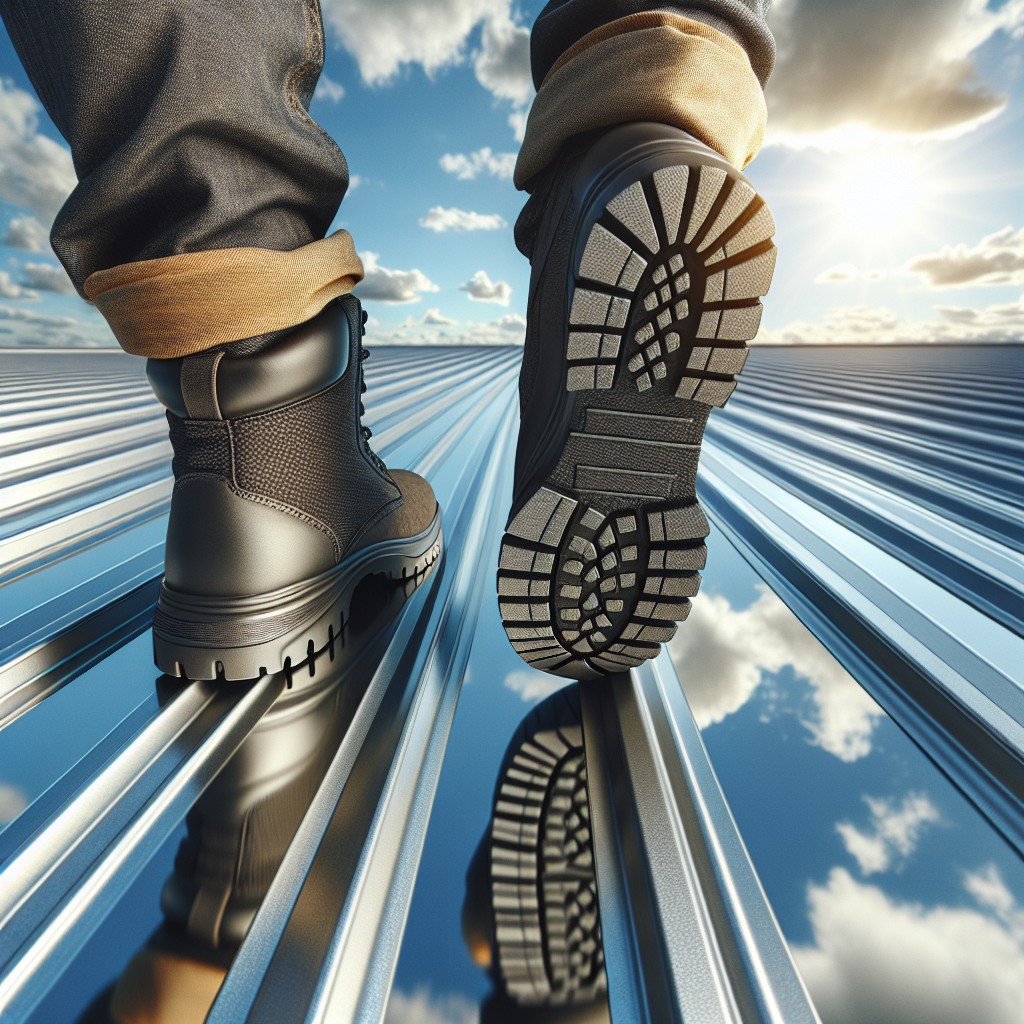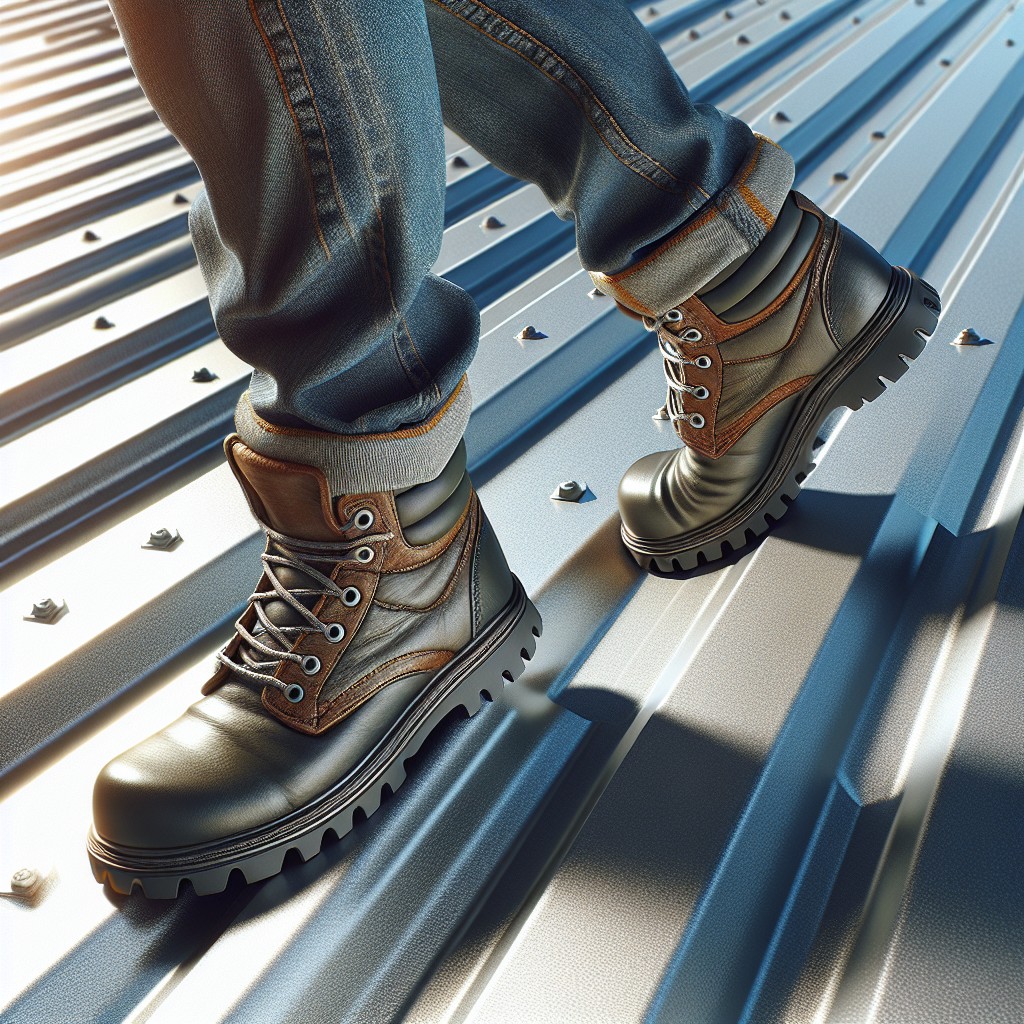Last updated on
Master the art of walking on a metal roof safely, because this skill could save you costly repair bills or even dangerous accidents.
Key takeaways:
- Choose shoes with non-slip rubber soles
- Prioritize areas with structural supports for stability
- Always check the weather forecast before attempting to access the roof
- Use fall protection gear and safety equipment
- Understand the structural composition of the metal roof
Choose the Right Footwear

Selecting appropriate footwear is critical for safety and ease when navigating a metal roof. Opt for shoes with non-slip rubber soles to enhance grip and reduce the risk of slips. Shoes with deep lugs can improve traction, but take care to avoid those with metal or hard plastic components that could scratch or damage the roof surface. Lightweight and flexible shoes will allow for better mobility and foot sensitivity, enabling you to feel the roof beneath you and react quickly to any changes in traction. Overall, comfort and support are as important as the sole’s quality; this ensures that you can move confidently and safely across the metal surface.
Rubber Soles and Lugs

Selecting the proper footwear is pivotal when navigating a metal roof. The soles should be made of soft rubber to enhance grip and minimize the risk of slips. Additionally, look for boots or shoes with deep indentations or lugs. These provide crucial traction that can prevent dangerous falls.
Always inspect the tread for wear and tear before climbing onto the roof, as worn-out soles greatly reduce the effectiveness of your footwear’s grip. It’s worth noting that some manufacturers offer footwear specifically designed for metal roof work – these may be a worthwhile investment for frequent maintenance or construction tasks.
Basics of Traction On Metal Roofs
Navigating a metal roof safely hinges on understanding traction. On these surfaces, traction is reduced due to their slick nature, especially when wet or covered in dust. Here’s how to maximize grip while moving across a metal roof:
1. Surface Condition: Before stepping onto the roof, inspect it for moisture, pollen, sawdust, or any debris that could compromise footing.
2. Walking Technique: Employ the “three-point contact” rule — always have either two feet and one hand or two hands and one foot in contact with the roof or ladder for stability.
3. Speed and Pressure: Move deliberately and apply even pressure with each step to prevent slipping and to allow for adjustments as needed.
4. Path of Travel: Plan your route to avoid unnecessary backtracking and to minimize the distance walked.
5. Avoid Steep Angles: Stay away from the edges and peak of the roof where the slope increases and traction naturally diminishes.
By adhering to these points, you can traverse a metal roof while maintaining the necessary traction to ensure safety.
Wait for a Clear Day
Optimal weather conditions are critical when planning to walk on a metal roof. Precipitation, such as rain, snow, or even morning dew, can significantly increase the risk of slipping due to the slick surface these elements create on metal.
Additionally, high winds could impact balance and stability, further endangering safety. For these reasons, it’s advised to schedule any roof work for a day that promises clear skies and calm weather. Not only does this provide a safer environment, but it also ensures better visibility and more predictable roof conditions, reducing the likelihood of accidents.
Always check the weather forecast before attempting to access your metal roof, and avoid any weather-related dangers by postponing activities if conditions seem unfavorable.
Fall Protection and Safety Equipment
Prioritizing safety is essential when walking on a metal roof. Here’s a rundown of fall protection gear and practices to employ:
- Harness and Anchors: Wear a full-body harness connected to a securely installed anchor point. The harness should fit snugly yet allow full range of motion.
- Roof Lanyards and Lifelines: Use lanyards and lifelines to limit the distance you can fall. Ensure they are of appropriate length and flexibility for the task.
- Toe Boards and Roof Brackets: Install toe boards along the roof edges to provide a secure foothold. Roof brackets can also be used to create a temporary platform for additional support.
- Guard Rails: When regular roof access is required, consider installing guard rails as a permanent safety feature to prevent falls.
- Roofing Ladder or Crawling Boards: These provide a stable path across the roof, distributing your weight evenly and reducing the likelihood of slipping.
Remember, even with these measures in place, always move cautiously and stay aware of your surroundings. Safety equipment should be inspected regularly for wear and damage to ensure its effectiveness.
Controlled Steps, Careful Movements, and Stability
Navigating a metal roof requires a methodical approach:
- Plan your path: Prioritize areas with structural supports to distribute your weight evenly.
- Maintain a low center of gravity: Crouch slightly when walking to increase balance.
- Move slowly: Rushed movements can lead to slips or falls. Take your time.
- Use a spotter: A partner on the ground can guide your steps and monitor safety.
- Avoid sudden changes in direction: Envision your route and commit to it to prevent missteps.
- Step flat-footed: This maximizes contact with the roof, enhancing stability.
- Stay focused: Keep your attention on the task, especially in areas near the roof’s edge.
Knowledge of Metal Roofing
Understanding the structural composition of metal roofs is crucial for safe navigation. Different materials, whether it’s aluminum, steel, copper, or a metal alloy, respond differently to weight and movement. Recognize the type of metal and its characteristics, including its tendency to dent or become slippery when wet.
Familiarize yourself with the layout, noting the position of fasteners, seams, and any underlying support structures. These areas may provide more stability as you move. Ensure you know the roof’s pitch, as steeper slopes require additional safety measures.
Being aware of any recent maintenance or coatings applied to the roof can also affect traction. Silicone or other protective layers might alter the surface’s grip. Acknowledge any visible damage or wear signs on the metal panels, as they could indicate weakened spots that may not support weight adequately.
Overall, prior knowledge of the roof’s condition, material properties, and structural layout contributes to safer navigation and damage prevention to the roofing surface.
Professional Roofer or DIY?
Deciding whether to hire a professional roofer or attempt a do-it-yourself approach depends on several factors. If you lack experience or are uncomfortable with heights, it’s safer to enlist an expert. Professionals have the proper equipment, experience, and insurance to handle the risks associated with working on a roof. They are trained to navigate various roofing materials safely and efficiently, reducing the risk of damage to your roof and injury to yourself.
For minor maintenance or tasks such as cleaning gutters, a confident homeowner with the appropriate safety gear may choose to proceed on their own. However, if the project involves extensive work or repairs, professional services are strongly advised. Roofing contractors can also provide warranties on their work and materials, offering peace of mind that DIY efforts cannot match.
Regardless of the choice made, always prioritize safety. Use a harness, work with a buddy, and ensure a safe method of ascent and descent. When in doubt, consult with a roofing professional to evaluate the task at hand.
FAQ
Is it OK to walk on a metal roof?
Yes, it is safe to walk on a metal roof, however, it’s recommended to walk closer to the roof decking for metal tile roofing while standing seam roofing and corrugated panels can be walked on anywhere without causing damage.
What kind of shoes are best for walking on metal roof?
The best shoes for walking on a metal roof are rubber boots with lugs as these offer maximum grip and stability regardless of the roof surface being smooth or rough.
How do you not slide on a metal roof?
To avoid sliding on a metal roof, it is advisable to wear soft, flexible shoes with rubber soles and comprehensive grip such as tennis shoes, Converse, or skate shoes which usually have flat soles.
Can you walk on a 29 gauge metal roof?
Yes, it is possible to walk on a 29 gauge metal roof.
How frequently can one safely navigate on a metal roof without causing damage?
Navigating a metal roof without causing damage can be safely done once or twice a year, contingent on weather conditions and proper footwear being used.
What are the necessary safety precautions to take when walking on metal roofs?
Key safety precautions when walking on metal roofs include wearing non-skid footwear, using a safety harness, and avoiding walking on the roof during wet conditions, additionally, one should always walk along the seams where the roofing is strongest.
Does the weather condition affect the safety and feasibility of walking on a metal roof?
Yes, weather conditions significantly affect the safety and feasibility of walking on a metal roof as wet, snowy, or icy conditions can make it highly slippery and dangerous.
Related
- How to Keep from Sliding on a Metal Roof: Comprehensive Guide for Safety Measures
- How to Walk on Clay Tile Roof: Safe and Easy Steps
- If Climbing Onto a Roof, How Should You Exit onto the Roof Top? Step-by-Step Process Explained
- Can You Walk on a Metal Roof Safely? Step-by-Step Guide
- How to Work on a Steep Roof: Safety Tips & Techniques
